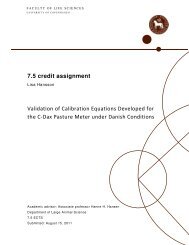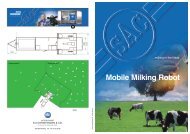Innovative Technology and Sustainable Development of Organic - 1.
Innovative Technology and Sustainable Development of Organic - 1.
Innovative Technology and Sustainable Development of Organic - 1.
You also want an ePaper? Increase the reach of your titles
YUMPU automatically turns print PDFs into web optimized ePapers that Google loves.
Table 3. Mean results <strong>of</strong> environmental indicators for dairy farms with an automatic milking system<br />
(AMS) <strong>and</strong> with a conventional milking system (CMS) in 2005 (SD in parentheses).<br />
Indicator Dimension AMS CMS P value<br />
Surplus N at farm level kg N/ha 110 (29) 66 (40) 0.02<br />
Surplus P at farm level kg P/ha 8.8 (6.6) 3.4 (8.7) 0.16<br />
Surplus N on grazing fields kg N/ha 92 (82) 166 (60) 0.05<br />
Surplus N on mowing fields kg N/ha 148 (79) 53 (80) 0.03<br />
Average field size ha 5 (<strong>1.</strong>1) 5.3 (3.8) 0.84<br />
Plant species grazing fields No/ha 5.4 (<strong>1.</strong>3) 5.6 (2.1) 0.83<br />
Plant species mowing fields No/ha 3.4 (2) 2.4 (<strong>1.</strong>1) 0.20<br />
To explain our obtained results we used general characteristics <strong>of</strong> sampled farms as presented in Table<br />
1 <strong>and</strong> parameters registered to capture grazing behaviour at AMS <strong>and</strong> CMS farms, which are presented<br />
in Table 4. It was expected that AMS farms would have a higher N surplus on their grazing fields,<br />
because <strong>of</strong> relatively few pastures around the barn suitable for grazing. However, the area <strong>of</strong> grassl<strong>and</strong><br />
available for grazing per dairy cow did not differ between AMS <strong>and</strong> CMS farms (Table 1). The amount<br />
<strong>of</strong> dry matter uptake from grazing, however, between AMS <strong>and</strong> CMS farms showed a tendency to be<br />
different (P = 0.09, Table 1). This was supported by registration <strong>of</strong> the amount <strong>of</strong> time cows spent<br />
grazing outside, which was higher for CMS than for AMS farms (P < 0.001). The fact that cows on<br />
CMS farms spent more time grazing outside causes extra N excretion on grazing fields, which explains<br />
the higher N surplus on fields used 100% for grazing. Consequently, on CMS farms, less excrement is<br />
deposited in the barn, <strong>and</strong> therefore less manure is applied on mowing fields, explaining the lower N<br />
surplus.<br />
Table 4. Parameters registered to capture grazing behaviour.<br />
Dimension Parameter AMS CMS P value<br />
kg DM/LU Concentrates fed per LU 1)<br />
7.3 (<strong>1.</strong>6) 6.3 (<strong>1.</strong>7) 0.2<br />
kg dm/day Grass uptake from pasture 2)<br />
5.1 (<strong>1.</strong>6) 6.9 (2.2) 0.09<br />
h/year Grazing time<br />
968 (198) 2,083 (788)




